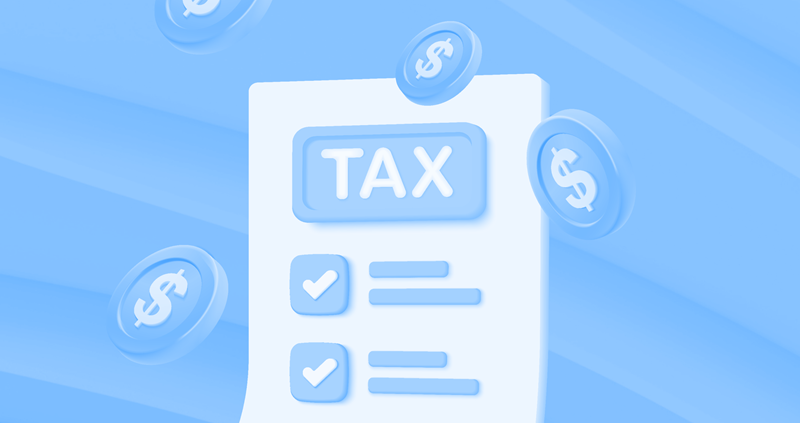Federal income tax rates explained
Federal income tax funds essential government services.
Tax rates are percentages applied to income, while the total tax is the dollar amount owed.
The US uses progressive tax brackets; higher incomes are taxed at higher rates.

What is the federal income tax rate?
Federal income tax is a tax imposed by the U.S. government on the taxable income of individuals, businesses, and other entities. It’s a major source of government revenue, helping to fund essential services like national defense, infrastructure, education, and social programs.
The federal income tax rate refers to the percentage of your income that goes toward taxes, but it’s important to distinguish between the tax rate and the total amount you owe.
The rate is the percentage applied to your income, while the total tax owed is the actual dollar amount you’re required to pay.
Though tax rates are expressed as percentages, they ultimately determine how much you contribute in taxes. This system ensures the government has the necessary funds to operate and support programs that benefit the country.
Federal income tax rate brackets
The U.S. federal income tax system uses a progressive structure, meaning higher incomes are taxed at higher rates. This is done through tax brackets, which divide taxable income into ranges, each assigned a specific tax rate.
One key thing to understand is that tax brackets work marginally. This means different portions of your income are taxed at different rates — not that your entire income is taxed at the highest bracket you reach.
For example, if part of your income falls into a 10% bracket, another portion into a 12% bracket, and so on, only the income within each range is taxed at that specific rate. Your entire income isn’t taxed at the highest rate you hit.
A common misconception is that moving into a higher tax bracket means your entire income is taxed at that rate, which isn’t true. Only the portion within that higher bracket is taxed at the new rate, while the rest remains at lower rates.
Understanding how tax brackets work can help you better estimate your tax liability.
Federal income tax rates 2025
Tax Rate | Income Range |
|---|---|
10% | $0 to $11,925 |
12% | $11,926 to $48,475 |
22% | $48,476 to $103,350 |
24% | $103,351 to $197,300 |
32% | $197,301 to $250,525 |
35% | $250,526 to $626,350 |
37% | Over $626,350 |
For 2025 federal income tax rates for those married filing jointly, please see the below table:
Tax Rate | Income Range |
|---|---|
10% | $0 to $23,850 |
12% | $23,851 to $96,950 |
22% | $96,951 to $206,700 |
24% | $206,701 to $394,600 |
32% | $394,601 to $501,050 |
35% | $501,051 to $752,700 |
37% | Over $752,700 |
And for those filing as head of household, 2025 federal income tax rates are as follows:
Tax Rate | Income Range |
|---|---|
10% | $0 to $16,100 |
12% | $16,101 to $64,150 |
22% | $64,151 to $103,350 |
24% | $103,351 to $197,450 |
32% | $197,451 to $250,800 |
35% | $250,801 to $631,350 |
37% | Over $631,350 |
For the 2025 tax year, the standard deduction is $15,000 for single filers, $30,000 for married filing jointly, and $22,500 for heads of households.
Always be sure to check official IRS resources or consult a tax professional for the most up-to-date information based on your specific situation.
Also, remember that these rates apply only to the 2025 tax year. Tax laws and rates can change, so always refer to the latest IRS updates when planning your taxes.
How to calculate your federal income tax
Calculating your federal income tax can seem daunting but breaking it down step by step can make the process more manageable.
While this section provides a simplified overview, it's crucial to remember that individual tax situations can be complex, and consulting a tax professional or using reputable tax software is always recommended for personalized guidance.
Here's a simplified example of how to calculate your federal income tax using the 2025 tax brackets for a single filer (remember to use the most current brackets when filing):
1. Determine your taxable income
This is your gross income minus any allowable deductions and exemptions. Deductions and credits significantly impact your taxable income and therefore, the applicable federal income tax rate.
2. Apply the tax brackets
- First $11,925 at 10% = $1,192.50
- Next $36,550 ($48,475 − $11,925) at 12% = $4,386
- Next $54,875 ($103,350 − $48,475) at 22% = $12,072.50
- Next $93,950 ($197,300 − $103,350) at 24% = $22,548
- Remaining $2,700 ($200,000 − $197,300) at 32% = $864
3. Calculate total tax
Add up the amounts: $1,192.50 + $4,386 + $12,072.50 + $22,548 + $864 = $41,063. This is your estimated federal income tax liability before considering any tax credits.
4. Consider tax credits
Tax credits directly reduce your tax liability. If you are eligible for any credits, subtract them from your total tax calculated in step three.
Federal income tax: A key to financial wellness
Navigating federal income tax can feel overwhelming, but understanding tax rates — especially the current ones—is a crucial step.
While this post has offered a glimpse into the mechanics of tax brackets and calculations, it's just the starting point. Taxes are dynamic and personal, and your specific circumstances will influence how these rates affect you. Staying informed and seeking professional guidance when needed is essential for responsible tax planning.
A strong understanding of federal income tax rates empowers you to make informed financial decisions and ensures you meet your tax obligations accurately. Resources are available to help you navigate the system with confidence.
Want to learn more about taxes and how taxation works? Raisin's Tax Guides offers valuable insights and resources to help you navigate the complexities of the tax system.
The above article is intended to provide generalized financial information designed to educate a broad segment of the public; it does not give personalized tax, investment, legal, or other business and professional advice. Before taking any action, you should always seek the assistance of a professional who knows your particular situation for advice on taxes, your investments, the law, or any other business and professional matters that affect you and/or your business.


